Takamine CTP 2 Cool Tube PreAmp NOS with How To Use Tutorial / Authorized Dealer
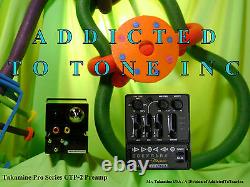

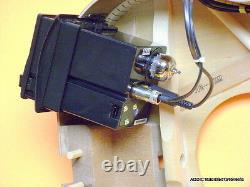
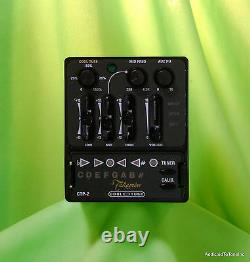
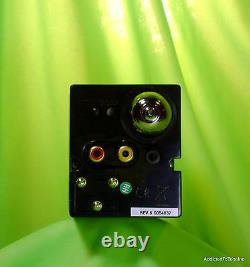
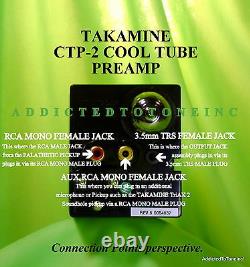

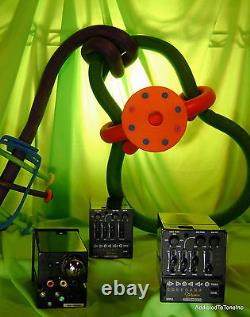


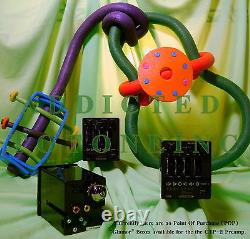


AddictedToToneInc places 35+ Years of Takamine. Please take the time to read the entire listing, the information.
It contains can answer many questions you may have. If you are still unsure about a detail please contact me; I will help you! William Bill Sutherland / AddictedToToneInc. Photographic and written work presented in this ad are property of AddictedToToneInc.Any portion of its use. The most current and up to date Revision #6. Will also include these items.
1 (one) preamp removal tool. Copy of the Original Owners Guide. "How to get a great tone quickly with the CTP-2 preamp". This PreAmp is covered by. "As new" because the preamp was removed from a new guitar are. The old "Tan/Green" KAMAN Corporation box has not been used since late 2009.The Black/Blue box has not been used since early 2012 notice there is no Distributor name on the Black/Blue box. The "Black/Blue" box was an interim transitional box used while the Takamine KAMAN distributorship. Takamine the company is unchanged, just the U. Company in charge of Takamine product distribution has changed. The best way I can describe it is it's like the difference between playing.
Through a good tube amp vs. The tube produces an even harmonic waveform that preserves and enhances. The complex natural tone structure produced by an acoustic guitar. Most players use adjectives like warm, bold, natural and woody to describe it.
Addicted To Tone Inc is an AUTHORIZED Repair Center for Takamine Guitars! This preamp is designed for use in Takamine brand guitars only!
The PreAmp DOES NOT come with a mounting chassis. The PreAmp Mounting Chassis is installed at the Takamine factory during. The guitar manufacturing process; if your guitar does not currently have a Mounting Chassis. Installed please do not order this PreAmp as you will have no way to insert it into the guitar. This preamp will NOT retrofit into the electronic chassis of other guitar brands, it is designed for Takamine brand guitars only.
Your Takamine guitar must have the same sized electronics to use the CTP-2. Here is a PARTIAL list of Takamine preamps whose mounting chassis will accept the CTP-2. AD-1, ATT-1, AccurAcoustic, CTP-1, CTP-2, CTP-3, CT4B, CT-4BII, CT4-DX, DSP, Graph Ex, TK-40.
TK-40B, TK-40D, TP-4, TP-4T, TP-4T D , TP-E, Parametric Equalizer, Takamine Equalizer, N4B, WOS14. These preamps are 2 7/16.If your current preamp is not this size it will not fit. O lder Takamine preamps TV3N, TK4NT, TS-1, TS-2, PT007S, etc. Are a different size and shape than the CTP-2. And are located in a different location on the guitars side; the mounting chassis of these preamps WILL NOT accommodate the CTP-2 preamp. For those of you installing this pre-amp into your "G" series Takamine.
The adapter simply plugs in and requires no modification to the guitar. These custom adapters are available ONLY at the time of order. Exclusively to clients who are purchasing a preamp directly from. If you need one of these items notify me before purchasing. Other unusual hard to find and custom made items!
Sometimes in this fast paced electronics driven world we lose touch with the humanity. I welcome your questions and speaking with you personally. William "Bill" Sutherland / AddictedToToneInc. As a consumer I understand the desire to save a couple dollars whenever possible.
And was not pleased with the result to much damage! The item listed in this ad is designed to improve the tone. Of your Takamine guitar or for replacing a defective component. I can help you diagnose the problem with your Takamine system. Please contact me before you order an item you do not actually need. Specifically repair technicians that do not know how to properly diagnose. Defects of the individual components used in the Takamine electronic system.AddictedToToneInc checks each component for electronic defect. When the new product is received from Takamine and. Non electronic parts like Tuners, Nuts, Saddles are carefully inspected and tested; any part that requires assembly is assembled.
The testing process was originally started for the sake of my over-seas patrons but I quickly realized the value of it for all my clients! I have designed, created and employ special testing equipment for the Takamine preamps and electronic components because it is your reputation as well as mine at stake when you walk on stage! AddictedToToneInc hosts a special Facebook page that specializes in the science and use of the Takamine technology exclusively for our Takamine clients. If you are having your item delivered to a temporary living. Address: Hotel, Motel, Day Suite etc. Make sure the name listed on the package is also attached to. If the recipients name on the. Package does not match a name in the guest registry there is no.As you may or may not know.. Since the early 70's KAMAN Music was the sole distributer of Takamine guitars in the U. Recently ESP Guitars and Takamine Guitars announced a partnership in which Takamine. Instruments will be distributed exclusively exclusively through ESP Guitars in the U.
Because of this new chapter in American Takamine history some printed materials have yet to. Be revised for the new ESP distributorship. For this reason, this sale is for preamp only, it does. Not come with glamour box.Your CTP-2 PreAmp will be sent very carefully and safely packaged. Here are some of the most Frequently Asked Questions I receive. Regarding the CTP-1, CTP-2, CTP-3. The TriAx, Acoustic DI + Box. And 4-pin Upgraded Phantom Power jacks.
Question : I have CTP-1 and on the back there are two switches. Do you know what these do? Answer : The PWR (Power) switch allows one to keep the power on so the tube is continuously warmed up and always ready for performance - you will go through batteries a lot with this switched on. You probably don't want to do this until you are using the Takamine DI+ to provide phantom power to your CTP-1 unit. The "High" switch gives you more gain.
The CTP-2 has a much faster warm up period (well under a minute) and features a switch marked Artist to keep the tube performance ready at all times. This is really a great concert feature that allows guitarists to change instruments quickly during a live performance on stage where seconds tend to feel like hour! You probably do not need it on at home. Question: Do I have to assemble the CTP-2 preamp myself? In one of your pictures it shows the preamp in pieces. Answer: No assembly is required; it will come brand new in box fully assembled. I included the dis-assembled pictures so curious people (like me) could see what they look like inside.The disassembled model was an older CTP-2 Takamine sent me to do "experiments" with. It helps me to know the equipment inside and out!
Question : Will (high quality) rechargeable AA batteries work as efficiently as normal AA batteries in the CTP-1/CTP-2? Question : Can I swap tubes in the CTP-2? Answer : Yes, y ou are able to swap tubes.
Question: How long does the 12Au7 tube last before it needs to be replaced in the CTP-2 preamp? Can I change to NOS tube when the tube is blown? Answer: How long does the 12Au7 last? The voltage to the tube is nowhere near that of a guitar amplifier. I would say in your lifetime you will never have to change the tube.
Can you change to NOS tube, when the tube is blown Yes. Question: I have a Takamine EG523SC with TK4NT. What alternative do you recommend as the TK4NT is no longer available? Answer: There is no easy solution for you. The TK4NT is a different size than the CTP-2 and all of the other current Takamine preamps.
If you just want to upgrade into a better sound you would have to first change the mounting bracket that is in your guitar, the mounting bracket that you currently have will not fit. The correct mounting bracket is a different size and shape so you would have to cut a new opening for it.
Perhaps now is a good time to upgrade guitars! Question: You mentioned about an RCA adapter needed for plug upgrades from TP4T and TK40 model preamps how come that is needed? These 3.5mm plugs look like a miniature version of your 1/4 jack that you use to plug your guitar into an amp. Since the CTP-2 requires an RCA style plug like you would use to plug up a VCR or DVD player you have to replace the 3.5 mm style jack.
It is a very simple modification to do, you simply cut the old style 3.5mm plug off and solder on the RCA style jack. Ultimately it is just a different style plug, the 3.5mm jacks were kind of delicate and prone to shorting out, and the RCA jacks are much sturdier. The main reason the 3.5mm plug was used on the more economical guitar models is a manufacturing detail: they could be soldered together and then passed through the top of the guitar with no additional work making them easier and faster to use, thereby lowering the cost of each unit.
Just look inside you guitars sound hole at the back of the preamp and you can see which style you have. Question: How long does the 12Au7 in the CTP-2 preamp last? Answer: The voltage to the tube is not anywhere near what an amplifiers would be, I would say in your lifetime you would probably never have to change the tube.
Question: Is the tube in the CTP-2 replaceable? Question: Does the CTP-2 unit you sell use the same electronic contacts as the factory designed pre-amp? Answer: The CTP-2 is a Takamine factory designed preamp Takamine uses the same mounting bracket on all of its guitars making it possible to interchange them and upgrade them quite easily. The CTP-2 preamp has a 3.5 output and two RCA style inputs for pickups.All of Takamine preamps use the same 3.5 output. Question: I think there is something wrong with my preamps cables how can I check the cable when its inside the guitar?
Answer: The next most common problem is the 3.5 mm output plug from the preamp. These plugs have no outer protection so it is easy to short them out.
Try this: Remove the preamp from its holder and place it on top of your guitar put a cloth under it so it does not scratch the guitars surface. Now turn the preamp up and gently move the input and output jacks from side to side, you should be able to deduce the offending component pretty easily.
Have you or someone else ever removed your existing preamp? A large portion of the time acoustic guitar "preamp" problems are a result of the endpin jack going bad. Question: I got my CTP 2 yesterday.I installed it on my guitar and it works fine when I plug it into my amp. There is one problem however. The "oper" green light stays on even when it is plugged out which means that my battery will run out if I don't remove the battery pack after each time I plug in.
It also means that I won't be able to use the tuner every time that I want because the battery pack will be plugged out if I don't use my jack. Do you think that the unit may be a dud?
Please get back to me as soon as you can. Answer: Thank you for contacting me quickly - there is no cause for alarm.. There is a switch on the back of the CTP-2 called the "Artist Switch" when it is engaged it keeps the CTP-2 on and warmed up constantly. In concert this is a benefit because the guitar is ready to go at all times.
You do not want to use this feature until you get the Takamine DI box which powers the CTP-2 via the guitar cable. Question: Where is the Artist switch?
Answer: The Artist Switch is located above the RED RCA jack on the BACK of the CTP-2. It is a simple "press and release" button made of black plastic.Question: I have a G series Takamine - do I need to upgrade my whole inner cable, too? You said I need to change to a RCA male jack, but I don't know what it is. Answer: You do not have to change the whole inner cable, just the connectors on it.
Currently your system has 2 mini male jacks they need to be changed to 1 RCA male plug. Question: I currently have a CT-4B II pre amp and I would like to change to the CTP-2 - what modifications are needed to do so? The cool tube has three connections. I do not understand help! Answer: You would not have to modify anything. The CTP-2 has two RCA jacks: 1 RED and 1 YELLOW. The 3.5 mm output is where you plug in your guitar jack. Answer: There is enough wire to leave the pickups in place. Usually they are wrapped together and held in one spot so you will want to "untie" the bundle so to speak. Put a little cosmetic mirror in the sound hole and look around - you will see it.Question: I have a CTP-1 that uses a lot of batteries, there is no Artist Switch to turn off, what is going on? 1 The CTP-1 was noted to go through batteries pretty quick - usually 5 -6 hours.
This was one of the first revisions made with the CTP-2 - longer battery life. Later revisions also included faster warm-up time and the addition of an Artist Switch. 2 Your end pin jack may be wired incorrectly or be "damaged" in such a way that the preamp/batteries are on even though the guitar is un-plugged, which normally turns the system off.
3 If nothing is technically wrong with your system you could upgrade to the 4-pin jack and start using the Takamine Acoustic DI box (which sounds great) it will power the CTP-1 externally so you do not have to use batteries. 4 On some of the early CTP-1 preamps the tuner must be turned off manually after activating, leaving the tuner on for an extended period of time will drain the batteries. Question: Thanks for the pictures on how to wire the RCA solder. In the third pic it shows the two wires and the RCA male plug.Do you have to cut the ends off those two wires and strip them to the bare wire before you solder them to the RCA plug, or do you just solder them as they are? Is there a specific spot each of those wires needs to go to inside the RCA plug, or do you just solder them both to the RCA soldering port in whatever position or order?
Answer: Each of the cables have 2 wires inside 1 hot, 1 ground. You cut the old ends off and then strip the wires to expose the two wires. The 2 hot wires will be wired together going to the "tip" of the RCA jack.
The 2 ground wires are combined and are soldered to the "ground" of the RCA jack. Should take about 7 - 10 minutes, pretty easy. Question: Does the CTP-2 have to be plugged into an amp to enjoy the sound differences? Answer: Yes, you must be playing through an amplifier or P.
To realize the sound quality of the CTP-2. Question: If I wanted to fit this into a non Takamine guitar. What would I need to make this work? Answer: You MUST have a Takamine mounting chassis, without it your only other chance for installation is duct tape and I do not recommend that. These are not normally available as a separate item, sometimes due to a badly damaged Takamine guitar we are able to salvage its mounting chassis and offer it as an up-grade to non-Takamine users.
This chassis will NOT accept other brands of electronic preamps; it is for Takamine guitar electronics only. Question : The tubes in my guitar amplifier get very hot, wont the Cool Tube heat up my guitar and damage it?The techs at Takamine named the Cool Tube very appropriately it operates at just 3 volts and warms only about 2 degrees over room temperature; chances are your body temperature will heat your guitar up more than the CTP-2. The only thing that will get hot is your tone! - and maybe your love-life!
Question : What kind of tube is in the CTP-2? Question : I have been told that the first two numbers of my Takamine guitars serial number reflect the year it was made. Answer: The first 2 digits of the serial number is the year the guitar was manufactured.
1998 = 98, 2006 = 06 2011 = 11 etc. Question : How do I wire the 3.5mm output jack of the preamp? Answer: You need to use 3 wires: 1 for the TIP connection (hot) 1 for the RING (activates the battery in the preamp) 1 for the GROUND. You need to use a shielded cable.
If you use a 2 wire connection your battery will be on all of the time, even when you are unplugged from the guitar. Question : I have a Takamine that is 15 years old and I installed the CTP-2 cool tube preamp. This mic uses battery, will the 4-pin upgrade jack also supply power to the mic? Answer: No, It will not. Question: How many Cool Tube Revisions are there? Answer: Here is an overview of the revisions Takamine is constantly striving to improve the CTP-2.Technically the most current revision is now called the CTP-3! Revision 6 the latest incarnation of the Cool Tube preamp. The latest revision reflects the CTP-2 is compliant with part 15 of the American FCC regulations, similar to what wireless guitar and microphone systems passed through a few years back.
Still the same great tone! Revision 5 is the same electronically as the Rev. A, the revision merely referring to the factory they were manufactured in. A is the same electronically as the three, the revision merely referring to the factory they were manufactured in. Revision 3, basically the same as the second revision but enhanced with longer lasting battery life and heavier duty battery tray. The CTP-2 is identical to the CTP-1 but has the addition of an artist switch and a faster warm-up time. This was the first major electronic revision of the Cool Tube preamp. What is the difference between the CTP-3 and the CTP-2 preamp - do they have the same tonality? The CTP-3 has the same great tone musicians have come to love about the CTP-2 but with an additional parametric control. The Parametric EQ on the CTP-3 allows a musician to zero in on problem frequencies that are creating feedback and with pin-point surgical accuracy remove them.By reducing the gain associated with the particular cycle leaving the surrounding frequencies unaltered and natural sounding. Slider style Graphic EQs do not offer this kind of precision. If you are currently having feedback issues I would suggest the CTP-3 instead of the CTP-2. Think of the CTP-3 as a marriage between the CTP-2 and the CT4-DX preamps.
Question: The instructions at Takamine say the LED Lamp of the CTP-3 should g l o w solid red when the tube is warm, but mine never turns red. Answer: I would be interested to know where you read this about the LED lamp.. I have never counted more than 20 LED flashes and have even counted as few as 8 before the tube is warmed up ready to go. Maybe you referring to the tuner? When you press the tuner button once the tuner LED stays lit (and you can hear the guitar) when you press the tuner button twice the Tuner LED flashes. And now you are tuning in "Mute" mode (you can not hear the guitar) a third press restores you to the performance (no tuning) mode. Question: On the CTP-3 does the standby allow the tube to stay warmed up without draining the batteries as much? The one issue I have with my CTP-1 is that I have to unplug the guitar cable between sets to extend battery life and when I get back on stage it has to warm up again. Currently the CTP-2 is at Revision 6, revision 7 is called the CTP-3.The CTP-2 has a much faster warm up period 1. 20 seconds and features a switch marked Artist to keep the tube performance ready at all times. He CTP-3 standby allows the tube to stay warmed up without as much battery drain, though it will drain them some as will leaving your guitar plugged in but. Warms up so quickly this may be a mute. The soundhole is a little smaller than normal.
Answer: The TriAx needs a 3 5/8 opening to slip into without touching the sides of the soundhole. I once put a TriAx into a Takamine TC132 Classical which has a smaller sound hole. We had to slightly notch out the soundhole for the TriAx clamping screws but not much. Sometimes it is easiest to just take the mounting platform of the TriAx off before you place it in the guitar, this gives you a lot more "clearance" but does make putting the bottom clamp back on a bit difficult - but it can be done. Question: I will be installing the TriAx in a Takamine TAN15C by plugging into the CTP-2 AUX input.
Answer: No, the TriAx is separate from those controls, only the AUX volume will affect the TriAx. Answer: An easy way to start is set all of your controls on your amp and guitar "flat" - do not boost or cut any frequencies. Now on your Takamine preamp slide the bass EQ slider all the way down, leaving only the mid and treble frequencies at the "0" mid-point.
Now use your TriAx to supply the low end, keep turning it up until the "low-end" is equal in volume to the mid and treble frequencies. If you are experimenting with two separate channels you can now begin to exaggerate the "bi-amping" effect by adjusting the channel controls of your amp or p.
To get the best clarity. Keep in mind you are not trying to make one element do all the work but are tweaking them separately within their own strength: Magnetic field (TriAx) for low mids and bass response, transducer (palathetic) for upper mids and treble. You can get a lot more volume and clarity this way. Question: W hich is the best TriAx mode to combine with the Cooltube - Passive or Active?
Which gives the best results? The active setting is several dB hotter and would produce too much gain and create distortion. Try it both ways - trust your ears. "If it sounds good, it is good".
Question: When operating the TriAx together with the CTP-2 what gives the best sound quality? Answer: After much experimentation I have decided the sonically superior way to run this type of "two part" system is to keep the elements separate. You can try this pretty easily as I send the TriAx with a cable that allows it to be used completely on its own. Install the TriAx in your guitar but leave the cable hanging out of the soundhole so you can plug a cable into it.A piece of painters tape to hold the cable in place on the surface of the guitars top makes things a little "safer". Now plug the TriAx into your P. Or another acoustic amp channel. Use the TriAx to capture the low mid and bass frequencies of your instrument and use the palathetic to capture the high mids and treble. By using two separate channels you can really EQ these elements to their best result.
Two channels also allow an artist to do some interesting stereo imaging or effect processing. I do not run stereo live but I do mix my mag field and transducer pickups a little to the left and right when I record in the studio, it is much more exciting to the ear. In theory anything you can solder an RCA plug on and plug in will work - mic, keyboard, bass guitar, C. BUT since the ohmage and resistance of different pickups may not match what is required by the system there would be the risk of a very bad hum and or distortion being present.
I would use the TriAx - it sounds great and is designed for the CTP-2. If it sounds good it is good! Question : W hen using the TriAx in conjunction with the CTP-1/2 and the batteries fail, will the TriAx still work via the Aux control?
Answer : No, but I would not worry about the batteries suddenly going "dead" in the middle of a song or even the middle of a set, the system gives you plenty time to replace batteries before it stops functioning. When we tested this situation we performed our experiment using a CD player playing a music sampler disc through the AUX input of the CTP-2 preamp. We noticed a subtle difference in the volume of the system when the batteries reached about 1.25 volts each. This slight reduction in volume would probably not have been noticed in a "real life" situation but since we were measuring things electronically we did "catch" it.
The system did continue to work quite tonefully for nearly 2 1/2 hours after this point and stopped producing sound about 15 minutes after the "battery" indicator light had come on. The batteries measured 1.12 each volts at this point.
Question: Hi, I currently own a Takamine TAN15c and have installed an L R Baggs made TriAx. Is the TriAx the same as the M1 or is it the same as the M80?
If the M80 is different would it be possible to match it with the Takamine Cooltube Preamp the same as the TriAx? Answer: The TriAx is similar to the M1 Passive, but not exactly the same. Too much body resonance will produce feedback at louder volumes. Because of the M80s Passive side, it can be used with the CoolTube preamp with no issues. Answer: The TriAx is very similar to the Sunrise in its magnetic structure, almost identical in fact.The TriAx on the other hand references the top movement enough to make it a valid choice on a nylon string instrument especially if one were to be using the CTP-2 preamp. As the "math" of the TriAx and Sunrise are nearly identical and the fact that the TriAx references the movement of the guitars top and the Sunrise does not, I have to officially tip my hat to the TriAx as being the tonefully superior unit. A friend of mine had me install a Sunrise (I used to sell them) in his guitar several years ago and after a couple of years of playing gigs with it he somehow managed to lose it.
He called the next day to report that at his band rehearsal the previous evening his band mates kept remarking about how much better his guitar sounded. Question: What is the purpose of having no pole piece in the B string location and a deeply-seated pole piece in the high E position, and extra pole pieces of various sizes? The "B" is recessed farthest because its tension and pitch produces much more volume than do the other strings. The high "E" is set a little lower as well (not quite as low as the "B") because of the same effect. Question: I really liked your information about how these pickups work best - a blend as in understanding- mic + mag.I love the Sunrise and have used them for years preceding the TriAx. The TriAx is very comparable to the Sunrise in terms of its tonality and sonic capabilities. I believe their both rated for 116db before feedback - a snow mobile or motorcycle engine is usually around 100db, physical pain begins around 125db.. Before feedback means more tone and tone is what it is all about!
I wonder if I can ask a technical question of you. One is stereo, the other mono? Answer : The TRS ("Stereo") jack/plugs are a constant source of confusion because they can be wired for a variety of different purposes. When you plug in, the barrel of the cables 1/4" male phono jack "grounds out the "RING" connector and completes the "POSITIVE/HOT" side of the battery - pretty clever! It is best to unplug your guitar when not in use if it is plugged in the battery is activated.. We once did a cool modification for a fellow that employed a mercury style switch on the battery connection - the battery would come on automatically when he held the guitar in the playing position, kind of weird but he liked it..Question: Do you think I need the 4 pin upgrade jack now or when I upgrade my preamp? Answer: Realistically you only need the 4 pin upgraded jack when and if you ever start using the Takamine Acoustic DI box the 4. Pin is for the Phantom Power feature only. Question: How do you tell the hot wire apart from the ground wire? Answer: Hot wire is on the inside, ground wire "surrounds" it - which also helps deflect noise..
Question: Is the shape of the 4 Pin Upgrade Jack the same as the old style three pin Takamine jack? Answer: They are almost exactly the same. I say almost because the three screw holes are ever so slightly different in their placement. When you place the new 4 pin jack into the guitar you will see only about half of the previous screw hole.
You can either put the screws back in at a slight angle or spin the new jack a little bit and start new holes. Question : Will the 4-pin upgrade still work with older (1995 and older) Takamine guitars (pro series not'G' models) with the original older style preamps without being connected to the Takamine Acoustic DI box and/or without the CTP-2 Preamp? Answer : Yes, The 4 pin upgraded jack will work for those guitars.
The 4 pin upgrade jack is electronically compatible with all the Takamine style guitars. Question : Where do I get the upgraded 4pin jack?
Question : The Upgraded "4-pin" jack appears to be wired to the cable exactly the same as the old 1990 vintage jack that we are removing and replacing. I'm not clear on what the difference is and how the phantom power from the Takamine Acoustic DI + is going to function any differently than with the old vintage style jack I already have. Answer : Yes, they do appear nearly the same on the outside as the old jack but contained inside the upgraded jack the pins are arranged differently to supply the phantom power. Question: Would the 4 pin jack enable my CTP-2 Preamp to be powered by a harmony machine that provided phantom and not need batteries?
The issue is not voltage, it is current. Standard phantom does not supply enough current to power the tube properly. That is why we developed the DI+ to provide a dedicated power supply. Question: Does the 4 Pin Upgrade Jack for CTP-2 work with a normal passive DI and/or other brands of Direct Boxes other than Takamine?
Answer: Yes, they will work perfectly BUT you will not be able to take advantage of the phantom power that the Takamine DI provides to power the CTP-2, you will have to continue to use batteries to operate the CTP-2. I would like to offer two additional remarks about the Takamine DI box. 1 I have heard DIs that sound as good but not better and they are nearly double the price.
2 The CTP-2 is a very advanced circuit that does tend to use a lot of battery energy, the cost of battery savings alone makes the Takamine Acoustic DI a great choice. It sounds and looks fantastic and of course tone is the main factor to an acoustic artist. SIDE NOTE: The Takamine Acoustic DI box is terrific for bass guitar! Question: Does the Acoustic DI+ come with all the items in the box such as the stereo guitar cable, power supply and manual. Answer: Yes, it will come with the Acoustic DI box, TRS ¼ cable, battery adapter plate for the older CTP-1 unit, AC adapter, AC adapter two blade insert and the owners manual. It is new in the box just as it was sent to us from Takamine. Question: When using the Acoustic DI to power the CTP-2 and the preamp still has batteries in it, will the batteries still have a draw?In other words if not in use and plugged in w/batteries in the preamp but plugged into the DI will the batteries still be in the circuit and die after a while of non-use? I want to be able to use the on board tuner when not plugged in.
Answer: No problem - no battery draw! Only the phantom power supply in the Takamine DI box will do that via the 4 pin upgrade jack. The Takamine Acoustic DI is quite different from other units that supply phantom power it is the only thing that will power the CTP-2 correctly and safely. It is a proprietary circuit available only from Takamine.
Answer: Anything you can plug into the CTP-2's RCA jack would technically "work" electronically, even a CD player. What one person likes another may hate. For most players I believe their "tone choice" is a matter of what ad copy they have read and has appealed to them on some conscience level rather than what they have heard.
Question: I have a LR Baggs Para DI Box that has phantom power, will it operate the CTP-2 preamp? The power supply in the Takamine DI box is different (and proprietary) it is the only unit that will power the CTP-2 correctly - I just verified this for another customer last month.
Question: I was told that the CTP-2s battery should last about 24 hours and i was worried that the battery might go flat in the middle of a gig. Thank you for the wealth of correct info.
Answer: The battery life has been extended from the original 6 - 8 hours to 20 24, 25, 26, ? How long the batteries last are dependent on a few variables - the brand of battery you use and how "hard" you run the system (how far up you turn the tube). If you use the tube lightly you probably can get 24 26 hours out of the batteries, running it hard will probably be more like around 16 - 18. I always suggest the DI box because not only will it pay for itself quickly in battery savings it sounds GREAT!
Remember: ONLY the Takamine DI box will power the CTP-2 other sources of phantom power are not appropriate and do not have the right amount of voltage to run the system. Question : Hi I just received my Takamine Acoustic DI and I like it very much, thanks a lot!One question: It seems like the boost switch does nothing even at MAX boost. Also, the loop switch seems to do nothing, the unit seems to be looping always and the only way to stop it is by turning the loop return gain all the way down. It does power up my cool tube amp with no problem but the foot switches seem faulty. The Tri Ax makes this sound amazing with the cool tube pre-amp! Answer: These units are built like tanks I think I know what might be happening.
You should have your guitar plugged into the input of the Acoustic DI. On the opposite side of the pedal is located the Unbalanced OUTPUT (1/4) and the BAL LO Z XLR output. These are the only two outputs connected to the boost and FX Loop - the BUFFERED OUTPUT is not. The FX loop trouble may be associated to the same event: If you have your guitar plugged into the input and are coming out of the BUFFERED OUTPUT to go the amp then you are essentially by-passing the footswitch features. Your guitar is plugged into the input. LOOP SEND should go into the input of your FX unit. You come OUT of your FX unit and plug it into the LOOP RETURN. Come out of the UNBALANCED OUTPUT (1/4) and go to your amp. You can now come out of the BAL LO-Z OUTPUT and go directly to your PA or recording console. This is the most popular way to run the system. The BUFFERED OUTPUT is basically a special send coming right from your original guitar signal.There are some special occasions where this will come in handy for you - but maybe not right now. The Acoustic DI is a cool unit but a little confusing a first because you can do some many "tricks" with it.
You can call me here at the store if you would like 502 964 3342. If there is something wrong with the unit I will take care of it so do not worry. At this point maybe spend just a little more time with it. You probably should have the -12bD PAD button off right now..Let me know how that works out! It works perfectly when I ran it that way.
It was buzzing kind of loud and I pushed the ground lift button and - perfect silence. This is an amazing box! The item "Takamine CTP 2 Cool Tube PreAmp NOS with How To Use Tutorial / Authorized Dealer" is in sale since Saturday, December 5, 2015. This item is in the category "Musical Instruments & Gear\Guitars & Basses\Acoustic Electric Guitars".The seller is "addictedtotoneinc" and is located in Floyds Knobs, Indiana. This item can be shipped worldwide.
- String Configuration: 4, 6 or 12 string
- Model: CTP-2 Cool Tube PreAmp
- Series: Cool Tube
- Type: Pro Series Takamine CTP 2 Cool Tube PreAmp
- MPN: CTP-2
- Brand: Takamine

